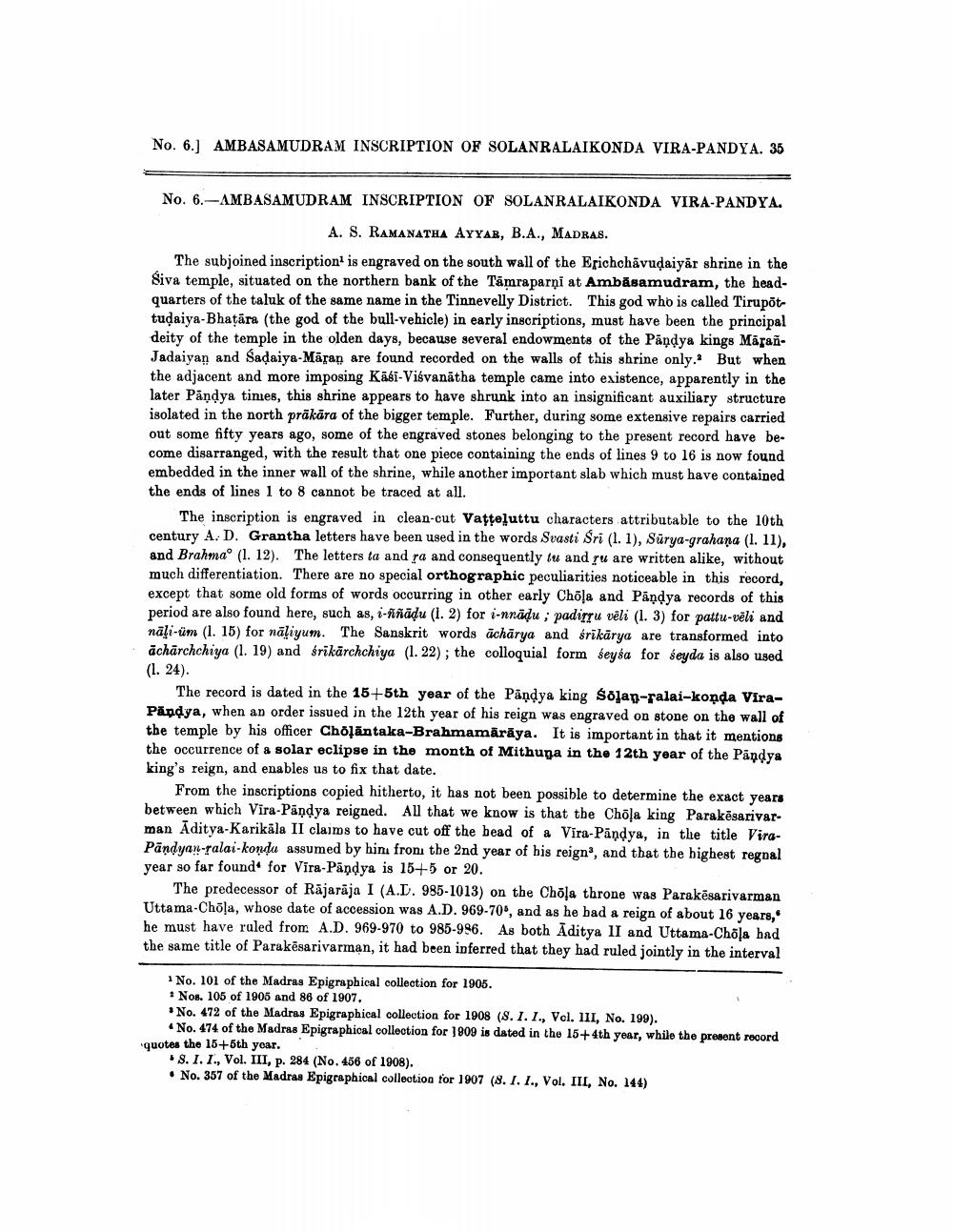________________
No. 6.) AMBASAMUDRAM INSCRIPTION OF SOLANRALAIKONDA VIRA-PANDYA. 35
No. 6.-AMBASAMUDRAM INSCRIPTION OF SOLANRALAIKONDA VIRA-PANDYA.
A. S. RAMANATHA AYYAR, B.A., MADRAS. The subjoined inscription is engraved on the south wall of the Erichchāvudaiyār shrine in the Siva temple, situated on the northern bank of the Tamraparni at Ambāsamudram, the headquarters of the taluk of the same name in the Tinnevelly District. This god who is called Tirupottudaiya-Bhatāra (the god of the bull-vehicle) in early inscriptions, must have been the principal deity of the temple in the olden days, because several endowments of the Pāņdya kings MārañJadaiyan and Sadaiya-Mārap are found recorded on the walls of this shrine only. But when the adjacent and more imposing Kāsi-Visvanātha temple came into existence, apparently in the later Pandya times, this shrine appears to have shrunk into an insignificant auxiliary structure isolated in the north prākāra of the bigger temple. Further, during some extensive repairs carried out some fifty years ago, some of the engraved stones belonging to the present record have become disarranged, with the result that one piece containing the ends of lines 9 to 16 is now found embedded in the inner wall of the shrine, while another important slab which must have contained the ends of lines 1 to 8 cannot be traced at all.
The inscription is engraved in clean-cut Vatteluttu characters attributable to the 10th century A. D. Grantha letters have been used in the words Svasti Sri (1.1), Sürya-grahana (1. 11), and Brahmao (1. 12). The letters ta and ra and consequently tu and ru are written alike, without much differentiation. There are no special orthographic peculiarities noticeable in this record, except that some old forms of words occurring in other early Chola and Pandya records of this period are also found here, such as, i-fiñādu (1.2) for i-nnādu; padirru vēli (1. 3) for pattu-vēli and nāļi-üm (1. 15) for näliyum. The Sanskrit words ācharya and frikärya are transformed into ächārchchiya (1. 19) and frikārchchiya (1. 22); the colloquial form seysa for seyda is also used (1. 24).
The record is dated in the 15+5th year of the Pandya king Solap-ralai-konda ViraPāndya, when an order issued in the 12th year of his reign was engraved on stone on the wall of the temple by his officer Chölāntaka-Brahmamārāya. It is important in that it mentions the occurrence of a solar eclipse in the month of Mithuna in the 12th year of the Pandya king's reign, and enables us to fix that date.
From the inscriptions copied hitherto, it has not been possible to determine the exact years between which Vira-Pāņdya reigned. All that we know is that the Chola king Parakēsarivarman Aditya-Karikāla II claims to have cut off the head of a Vira-Pandya, in the title ViraPandyan-ralai-kondu assumed by hini froni the 2nd year of his reign®, and that the highest regnal year so far found for Vira-Pāņdya is 15+5 or 20.
The predecessor of Rājarāja I (A.D. 985-1013) on the Chola throne was Parakësarivarman Uttama-Chöļa, whose date of accession was A.D. 969-70, and as he had a reign of about 16 years, he must have ruled from A.D. 969-970 to 985-986. As both Aditya II and Uttama-Chöla had the same title of Parakësarivarman, it had been inferred that they had ruled jointly in the interval
1 No. 101 of the Madras Epigraphical collection for 1905. * Nos. 105 of 1905 and 86 of 1907. No. 472 of the Madras Epigraphical collection for 1908 (S.I.I., Vol. III, No. 199).
No. 474 of the Madras Epigraphical collection for 809 is dated in the 15+ 4th year, while the present record quotes the 15+5th year.
.8.1.1., Vol. III, p. 284 (No. 456 of 1908). • No. 357 of the Madras Epigraphical collection for 1907 (8. 1. I., Vol. III, No. 144)




